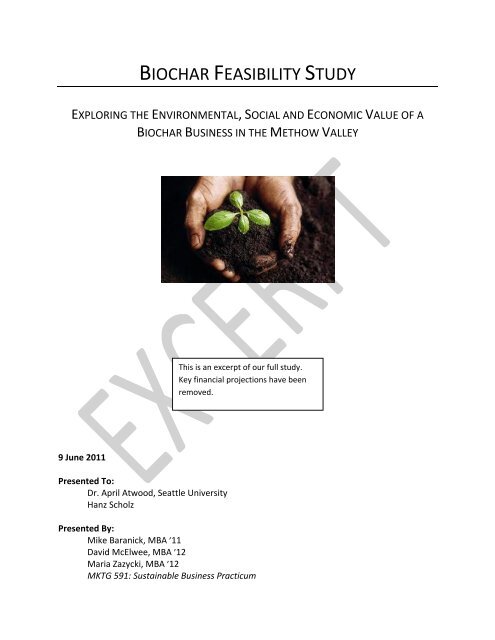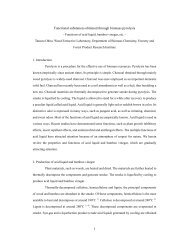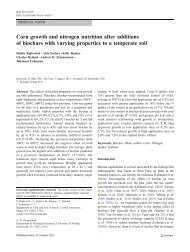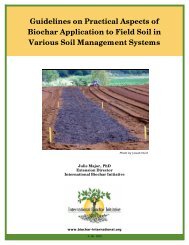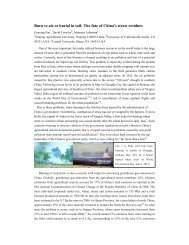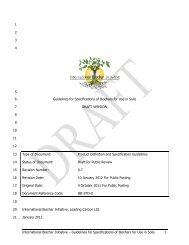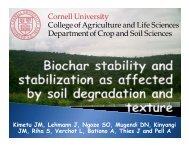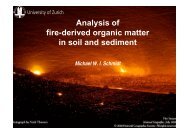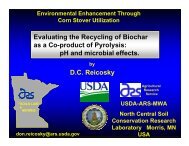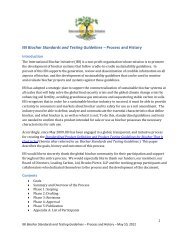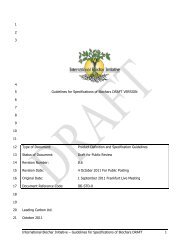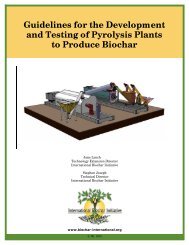Biochar Feasibility Study: Exploring the Environmental, Social and
Biochar Feasibility Study: Exploring the Environmental, Social and
Biochar Feasibility Study: Exploring the Environmental, Social and
Create successful ePaper yourself
Turn your PDF publications into a flip-book with our unique Google optimized e-Paper software.
BIOCHAR FEASIBILITY STUDYEXPLORING THE ENVIRONMENTAL, SOCIAL AND ECONOMIC VALUE OF ABIOCHAR BUSINESS IN THE METHOW VALLEYThis is an excerpt of our full study.Key financial projections have beenremoved.9 June 2011Presented To:Dr. April Atwood, Seattle UniversityHanz ScholzPresented By:Mike Baranick, MBA ’11David McElwee, MBA ’12Maria Zazycki, MBA ’12MKTG 591: Sustainable Business Practicum
TABLE OF CONTENTSExecutive Summary ......................................................................................................................... 3Project Overview ............................................................................................................................. 4Product Potential Assessment ........................................................................................................ 5Marketable Products ................................................................................................................... 5Product Value (Qualitative)......................................................................................................... 6<strong>Environmental</strong> Value ................................................................................................................... 8<strong>Social</strong> Value ................................................................................................................................. 9Market Potential Assessment ....................................................................................................... 10Product Life‐Cycle Considerations ............................................................................................ 10Industry Competition ................................................................................................................ 10Marketing Mix ........................................................................................................................... 12Challenges with <strong>the</strong> Market Model ........................................................................................... 14Recommendations & Conclusion .................................................................................................. 16Exhibits .......................................................................................................................................... 18Appendices .................................................................................................................................... 26Endnotes ....................................................................................................................................... 30ACKNOWLEDGEMENTSWe offer our deep appreciation to <strong>the</strong> array of individuals who shared<strong>the</strong>ir expertise, time, homes <strong>and</strong> talent with us. Research assistant,Michelle Dvorak, (SU ’14), under <strong>the</strong> guidance of Dr. Jennifer Sorensen,contributed <strong>the</strong> scientific research to demystify biochar for us. ArtDonnelly from SeaChar <strong>and</strong> Thayer Tomlinson of <strong>the</strong> International <strong>Biochar</strong>Initiative were critical to helping us underst<strong>and</strong> <strong>the</strong> biochar industry, whileU.S. Forest Service employees Meg Trebon, Arlo V<strong>and</strong>er Woude, <strong>and</strong> RichyHarrod helped us underst<strong>and</strong> <strong>the</strong> Okanogan National Forest. We are alsograteful to Ed Geiger, Russell Hagen <strong>and</strong> our client, Hanz Scholz, as well as<strong>the</strong> many biochar business owners who eagerly shared <strong>the</strong>ir knowledge of<strong>the</strong> industry with us. Finally, we gratefully acknowledge our professor, Dr.April Atwood, who guided <strong>the</strong> project through sound advice, <strong>and</strong> ourcolleagues in <strong>the</strong> Sustainable Business Practicum course, who acted as acritical sounding board throughout our biochar journey.<strong>Biochar</strong> <strong>Feasibility</strong> <strong>Study</strong> Page 2
EXECUTIVE SUMMARYAs part of <strong>the</strong> Seattle University MBA Sustainable Business Practicum course, our team of threestudents – Mike Baranick, David McElwee <strong>and</strong> Maria Zazycki (The Team) – conducted afeasibility study researching <strong>the</strong> environmental, social <strong>and</strong> economic value of a biochar businessfor our client, Hanz Scholz (The Client). Our client, who lives in <strong>the</strong> Methow Valley of NorthCentral Washington, was primarily interested in converting slash piles from forest managementactivities in <strong>the</strong> Okanogan National Forest into a biochar product that could be exported from<strong>the</strong> valley.Over <strong>the</strong> course of 10 weeks, we researched <strong>the</strong> product potential of biochar, analyzing itsbenefits as a soil amendment, alternative energy source <strong>and</strong> climate offset market investment.Our investigation took us from Seattle to <strong>the</strong> Methow Valley, where we obtained a betterunderst<strong>and</strong>ing of <strong>the</strong> forest management activities <strong>and</strong> <strong>the</strong> community in which our clientresides. <strong>Biochar</strong> has many benefits (carbon sequestration, soil amendment <strong>and</strong> clean energy)<strong>and</strong> thus has many potential revenue sources. While it is part of an emerging industry, it is alsovery diverse, with active companies, universities <strong>and</strong> non‐governmental organizations locatedaround <strong>the</strong> world. Through extensive interviews with biochar advocates <strong>and</strong> experts as well asbusiness leaders in <strong>the</strong> timber <strong>and</strong> forest service industries, we narrowed our research on <strong>the</strong>feasibility of marketing biochar solely as a soil amendment product.While some biochar soil amendment companies market <strong>the</strong>ir product as a mixed biocharcompost product, for simplicity sake, we focused on <strong>the</strong> o<strong>the</strong>r model – marketing 100%biochar. We analyzed two business models for selling 100% pure biochar. The supply businessmodel factors all <strong>the</strong> feedstock available from <strong>the</strong> Okanogan National Forest on an annual basis.Because this would require a large investment <strong>and</strong> produces more biochar than we think <strong>the</strong>reis a market for, we also created a second business model from <strong>the</strong> dem<strong>and</strong> side. This modelfactors in <strong>the</strong> current sales volume of <strong>the</strong> existing competitors based on industry dem<strong>and</strong>.RecommendationBoth of our business models prove that a biochar business in <strong>the</strong> Methow Valley will not beeasy to implement primarily due to <strong>the</strong> lack of consumer dem<strong>and</strong> relative to <strong>the</strong> supply offeedstock. To overcome this, we recommend our client build partnerships throughout <strong>the</strong>Methow Valley in order to leverage resources among <strong>the</strong> existing businesses throughout thisregion. We also advise he build alliances within <strong>the</strong> biochar industry in an effort to capitalize on<strong>the</strong> efforts to build project dem<strong>and</strong>. Fur<strong>the</strong>rmore, we recommend that our client implement ashort‐term pilot study of a small scale biochar operation. This should include producing biochar,testing it in a variety of soils <strong>and</strong> conducting consumer market studies.<strong>Biochar</strong> <strong>Feasibility</strong> <strong>Study</strong> Page 3
PROJECT OVERVIEWProject DescriptionBased in <strong>the</strong> Methow Valley of North Central Washington, our client was interested indeveloping a business model that would take advantage of waste biomass produced throughforest management practices in <strong>the</strong> Okanogan National Forest. The U.S. Forest Service (USFS)creates piles of slash – small‐diameter limbs, tops <strong>and</strong> miscellaneous residue left over fromforest management activities, such as thinning, pruning <strong>and</strong> timber harvesting. The piles ofslash are <strong>the</strong>n treated <strong>and</strong> safely burned as a way of disposal. The burning of slash piles is notonly expensive for <strong>the</strong> USFS, but it also emits harmful carbon dioxide into <strong>the</strong> atmosphere.Additionally, slash burning can significantly change soil processes, plant establishment <strong>and</strong>adjacent vegetation. 1 While <strong>the</strong> USFS is interested in finding alternative ways to remove <strong>the</strong>slash piles, <strong>the</strong>y face several challenges including an established market, safe access to <strong>the</strong> piles<strong>and</strong> federal regulations. 2By converting this product into biochar, our client proposed that we could not only avoid <strong>the</strong>harmful effects from burning slash piles, but also create an agricultural amendment productthat safely sequesters carbon. Fur<strong>the</strong>rmore, our client was interested in creating an exportableproduct that could provide living wages <strong>and</strong> improve <strong>the</strong> quality of life for members of <strong>the</strong>Methow Valley. Finally, as business students, we discussed framing <strong>the</strong> study around <strong>the</strong>potential for this biochar business to be profitable. In short, our client charged us with exploring<strong>the</strong> possibilities of creating a truly sustainable business – one that combines <strong>the</strong> aspects ofenvironmentally, socially <strong>and</strong> financially sound strategies into a successful business model.Because this study was part of our MBA coursework, we had only 10 weeks to complete <strong>the</strong>project. As such, we narrowed <strong>the</strong> scope of our project to solely focus on <strong>the</strong> value of a biocharsoil amendment start‐up business located in <strong>the</strong> Methow Valley. The intent is not to provideour client with a full business plan, but ra<strong>the</strong>r to underst<strong>and</strong> <strong>the</strong> commercial value of biochar asa soil amendment product, including market considerations <strong>and</strong> financial investments.Description of <strong>the</strong> Methow ValleyThe Methow Valley is located in North Central Washington, approximately 200 miles east ofSeattle, where <strong>the</strong> team is based. Tucked away in <strong>the</strong> North Cascades, <strong>the</strong> valley has apopulation of approximately 5100, including approximately 400 residents of Winthrop <strong>and</strong> 900residents of Twisp. 3 The Methow Valley is located within Okanogan County, of which 80% isrural. 4 Agriculture/ Forest/Fishing/Hunting is <strong>the</strong> primary industry in <strong>the</strong> Methow Valley(14.0%), followed by Accommodation <strong>and</strong> Food Services (12.9%), Educational Services (10.3%),<strong>and</strong> Construction (9.8%). 5 While tourism drives some of <strong>the</strong> economy in Winthrop, drawing inoutdoor enthusiasts who travel year round to hike, bike <strong>and</strong> ski, our client indicated that fewexportable products are created in <strong>the</strong> Methow Valley.Project Methodology <strong>and</strong> ObstaclesOur methodology included Interviews with biochar experts, advocates <strong>and</strong> business owners;research scientists; USFS employees; <strong>and</strong> residents of <strong>the</strong> Methow Valley. We also conducted<strong>Biochar</strong> <strong>Feasibility</strong> <strong>Study</strong> Page 4
extensive online research. To underst<strong>and</strong> <strong>the</strong> market, we studied many different componentsof <strong>the</strong> biochar industry – including diverse feedstock, conversion processes <strong>and</strong> marketableproduct types.Through our research process, we faced several unavoidable obstacles. First, was <strong>the</strong> limitedtimeframe of <strong>the</strong> project. Ten weeks is a short amount of time, especially considering <strong>the</strong> Teamconsists of only three part‐time graduate students. Second, we started with no underst<strong>and</strong>ingof what biochar is, nor did our professor <strong>and</strong> peers in <strong>the</strong> MBA class. In fact, we had neverheard of biochar prior to this project. This is not surprising, since biochar is an emergingindustry – which is part of <strong>the</strong> reason our client was drawn to <strong>the</strong> project. As a result, we faceda lot of scattered <strong>and</strong> somewhat contradictory information about biochar, its application <strong>and</strong> itscommercial value. Our final challenge was <strong>the</strong> fact that our team is not from <strong>the</strong> Methow Valleybut instead we live 200 miles away in Seattle. Working remotely on a business feasibility studyis challenging, especially when one of <strong>the</strong> goals of <strong>the</strong> study is to create a business thatpromotes <strong>the</strong> social <strong>and</strong> economic sustainability of <strong>the</strong> community in which it will reside.PRODUCT POTENTIAL ASSESSMENTMarketable Products<strong>Biochar</strong><strong>Biochar</strong> has been around for thous<strong>and</strong>s of years, dating back to <strong>the</strong> pre‐Columbian Amazoniannatives between 450 BC to AD 950. Modern day researchers were fascinated by <strong>the</strong> dark,nutrient‐rich soil that <strong>the</strong>se Amazonian natives left behind. This Amazonian soil has since beenreferenced to as “Terra Preta,” which translates to black earth. 6 <strong>Biochar</strong> is produced using atechnique called pyrolysis, in which biomass is heated in <strong>the</strong> absence of oxygen totemperatures between 300‐800 deg C. 7 The chamber in which <strong>the</strong> pyrolysis process occurs isreferred to as a kiln. There are three major outputs produced from <strong>the</strong> pyrolysis process, a solid(biochar), a liquid (oil) <strong>and</strong> a gas (syngas). The quantity of each output is determined by four keyvariables of <strong>the</strong> pyrolysis process: input material, water content, operating temperature <strong>and</strong>process time. Biomass that is heated between temperatures of 300‐600 deg C typically isreferred as a “slow” pyrolysis product, as <strong>the</strong> process time can take many hours. The benefit of<strong>the</strong> slow pyrolysis process is that up to 40% of <strong>the</strong> biomass input can be converted to biochar.The “fast” pyrolysis process occurs at temperatures above 600 deg C <strong>and</strong> can be completed inminutes; however, this process produces higher ratios of oil <strong>and</strong> syngas <strong>and</strong> less biochar. 8Exhibit 1 provides a high‐level overview of <strong>the</strong> pyrolysis process.The primary application of biochar is to be used as a soil amendment in agriculture. <strong>Biochar</strong> canei<strong>the</strong>r be applied directly to agricultural crops or used as a supplement in fertilizer or compost.When used as a supplement to fertilizer or compost, biochar can reduce <strong>the</strong> inputs of <strong>the</strong>seproducts by 25‐30%. The advantages of using biochar for agriculture applications will be fur<strong>the</strong>rexplored below.<strong>Biochar</strong> can also be used as an alternative fuel source, as many developing countries are using<strong>the</strong> charring process as a method to cook. These countries use specifically‐designed stoves to<strong>Biochar</strong> <strong>Feasibility</strong> <strong>Study</strong> Page 5
char <strong>the</strong> biomass input, releasing enough heat to cook food. Additionally, <strong>the</strong> biomass input ischarred throughout <strong>the</strong> cooking process, producing a biochar product equivalent to thatproduced within a kiln. 9 Therefore, <strong>the</strong> advantages to this process variation are three‐fold: thismethod (1) provides a means for developing countries to cook, (2) utilizes a renewable resourceas <strong>the</strong> fuel source, displacing <strong>the</strong> need for fossil fuels like natural gas, <strong>and</strong> (3) produces biocharas a byproduct.Byproducts (syngas <strong>and</strong> oil)Pyrolysis of biomass produces two primary byproducts: syngas <strong>and</strong> oil. Both byproducts can beused as fuel, providing clean, renewable energy. The syngas byproduct is a mixture ofhydrogen, carbon dioxide, carbon monoxide <strong>and</strong> hydrocarbons. 10 The primary application ofsyngas is to be used as an input in <strong>the</strong> pyrolysis process, ei<strong>the</strong>r as a heating source in <strong>the</strong> dryingprocess or in <strong>the</strong> kiln itself. Depending on <strong>the</strong> climate <strong>and</strong> geographical location, biomasstypically has to be dried in order to reduce <strong>the</strong> water content, as biomass with greater than20% water content is difficult to create biochar. 11 Therefore, this syngas byproduct can becomean essential piece of <strong>the</strong> pyrolysis process. Fur<strong>the</strong>rmore, syngas does not have to be processedor refined before reusing, thus creating yet ano<strong>the</strong>r advantage of this byproduct. Many kilns areable to capture <strong>the</strong> syngas <strong>and</strong> immediately reuse <strong>the</strong> byproduct as an input into <strong>the</strong> process,<strong>and</strong> as a result <strong>the</strong> production of biochar is a closed‐loop process. Excess syngas that is notreused in <strong>the</strong> pyrolysis process can be sold, which can be used to generate electricity or as alow grade fuel in boilers or cooking stoves.The second byproduct of <strong>the</strong> pyrolysis process is oil. This byproduct is not as beneficial assyngas, as <strong>the</strong> oil must be refined before using. The oil can be used as a st<strong>and</strong>alone product;however, <strong>the</strong> emissions can be heavy in particulates <strong>and</strong> black carbon. Therefore, it is bestpractice to upgrade <strong>the</strong> oil to a biodiesel, which can <strong>the</strong>n be used as a fuel for transportation.This application can be very beneficial, especially when <strong>the</strong> biochar production process requiresdelivering <strong>the</strong> feedstock to a central processing plant or if <strong>the</strong> biomass product is exported. Thisoil byproduct contains approximately 55% of <strong>the</strong> energy content by volume as diesel fuel.Pelleted <strong>Biochar</strong><strong>Biochar</strong> can also be pelletized, in which <strong>the</strong> primary application is to be used as residential orcommercial energy production. This pelletized biochar can be used as ei<strong>the</strong>r a direct heatsource or as an input to produce steam for electricity. <strong>Biochar</strong> pellets are advantageous in that<strong>the</strong> overall density is increased, <strong>the</strong>reby reducing transportation costs. 12 The pelleting processtakes place after pyrolysis <strong>and</strong> requires a pellet mill or press, along with a series of stepsdepending upon <strong>the</strong> size <strong>and</strong> amount of substrate. 13 Before a mill can be used, woodysubstrates should pass through a wood chipper <strong>and</strong> a "hammer mill" in order to create smallerpieces. Pellet mills are varied in <strong>the</strong>ir design <strong>and</strong> size, with larger engines necessary forcommercial processes. 14 Despite <strong>the</strong> potential market opportunities for pelleted biochar, <strong>the</strong>application of using <strong>the</strong> material as an energy producing resource will not be fur<strong>the</strong>r explored inthis feasibility study.Product Value (Qualitative)<strong>Biochar</strong> <strong>Feasibility</strong> <strong>Study</strong> Page 6
Soil AmendmentOne of <strong>the</strong> primary advantages of biochar is tobe used as a soil amendment in agriculture. Asstated above, biochar can be applied as ast<strong>and</strong>alone product or by combining withfertilizer or compost, which reduces <strong>the</strong>se inputsby up to 30%. The benefits of using biochar as anagricultural product are immense. <strong>Biochar</strong> has anextremely high surface area – a gram of biocharcan have approximately 25 square meters ofsurface area. 15 As a result of this high surfacearea, biochar acts as a “carrier” that can holdFigure 1: <strong>Biochar</strong>’s Porous Structure<strong>and</strong> retrain nutrients within its porousstructure. Therefore, when biochar is mixed with a fertilizer or compost it is able to store <strong>the</strong>nutrients in <strong>the</strong> ground for longer periods of time, thus reducing <strong>the</strong> future annual applicationsof fertilizer or compost. 16 Figure 1 provides an illustration of biochar’s porous structure.Reducing <strong>the</strong> quantity of fertilizer used inagricultural operations has enormous benefits,as <strong>the</strong> fertilizer emissions can often producedetrimental effects of <strong>the</strong> surroundingecosystem. Figure 2 provides an illustration of<strong>the</strong> “dead zone” in <strong>the</strong> Gulf of Mexico as a resultof <strong>the</strong> high levels of fertilizer runoffs that aretransported by large rivers like <strong>the</strong> Mississippi.Ano<strong>the</strong>r benefit of biochar when used in <strong>the</strong>agricultural industry is its ability to capturenitrogen <strong>and</strong> methane. High levels of nitrogen inFigure 2: Gulf of Mexico's Dead Zone<strong>the</strong> ground are problematic in that it can leachinto nearby groundwater. With regard to methane, one of <strong>the</strong> leading causes of globalwarming, biochar is able to sequester this gas <strong>and</strong> restrict its ability to enter <strong>the</strong> atmosphere.Additionally, biochar is also able to simulate mycorrhizal fungi colonization, which has <strong>the</strong>capacity to deliver nutrients, especially phosphorous, to plants for increased nutrient uptake<strong>and</strong> root growth. 17 Fur<strong>the</strong>rmore, Ponderosa pine <strong>and</strong> Douglas‐fir trees, abundant within <strong>the</strong>Methow Valley, can produce relatively high pH biochar. <strong>Biochar</strong> with higher pH levels increases<strong>the</strong> char’s electrical charge <strong>and</strong> can <strong>the</strong>refore attract even more nutrients, greatly improving<strong>the</strong> soil’s health. 18 Centuries of agricultural operations has caused detrimental affects to <strong>the</strong>world’s soil quality – <strong>the</strong> majority of <strong>the</strong> world’s soil is considered degraded, very degraded orwithout vegetation (See Exhibit 2). <strong>Biochar</strong> – with its ability to retain nutrients – is a solution tothis agricultural problem.<strong>Biochar</strong> <strong>Feasibility</strong> <strong>Study</strong> Page 7
Finally, biochar used as a soil amendment can also increase water retention. Like nutrients,water is attracted to biochar’s high surface area <strong>and</strong> porous structure. The benefits of waterretention are twofold. The first is <strong>the</strong> reduction of <strong>the</strong> water needed to maintain agriculturel<strong>and</strong>s. With rising costs of water – a direct result of <strong>the</strong> world’s diminishing supply of freshwater resources – amending biochar in soils can reduce utilities costs for agriculturaloperations. Secondly, many farmers tend to overwater <strong>the</strong>ir fields, which can cause nutrients<strong>and</strong> fertilizers to leave <strong>the</strong> soil <strong>and</strong> pollute nearby groundwater.When using biochar as a soil amendment, it is best to incorporate <strong>the</strong> char using mechanicalmachinery, as <strong>the</strong> biochar is most effective when applied at plant root depths. 19 Alternatively,<strong>the</strong> biochar can be placed in pre‐tilled soil; however, this incorporation method is less desirableas it may increase soil disturbance <strong>and</strong> decrease <strong>the</strong> overall biochar coverage. 20 <strong>Biochar</strong> is alsoeffective when mixed with ei<strong>the</strong>r compost or organic fertilizer, as previously noted.The amount of biochar that is necessary to significantly alter <strong>the</strong> soil density <strong>and</strong> nutrient levelsis dependent upon <strong>the</strong> existing soil condition, <strong>and</strong> researchers have yet to agree on a set ofst<strong>and</strong>ards regarding soil types. However, experiments have shown that <strong>the</strong>re is a positivecorrelation between <strong>the</strong> amount of biochar applied <strong>and</strong> <strong>the</strong> resulting increase in <strong>the</strong> nutritional<strong>and</strong> water retention characteristics of <strong>the</strong> soil. For instance, in an experiment on plots ofSavannah terra preta soils in Columbia, biochar was added by varying amounts per hectare ofsoil (0, 8 <strong>and</strong> 20 tons), with <strong>the</strong> most significant increases in nutrient retention occurring at <strong>the</strong>20 tons/hectare scenario. 21 Fur<strong>the</strong>rmore, in an experiment with typical Midwestern soils from<strong>the</strong> U.S., biochar was tested in an isolated container in <strong>the</strong> amounts of 0, 5, 10 <strong>and</strong> 20 gramsper one kg of soil. 22 The results indicated that <strong>the</strong> 20 gram biochar scenario raised <strong>the</strong> soil’s pHby 1 unit, while also increasing its water retention potential by 15%. 23Carbon Credits<strong>Biochar</strong> also has <strong>the</strong> future potential of participating in <strong>the</strong> very lucrative carbon offset market.The carbon offset market is divided into two distinct segments: a compliance market <strong>and</strong> avoluntary market. A compliance market is utilized by companies that purchase carbon credits inorder to comply with m<strong>and</strong>atory emissions caps. Conversely, carbon offsets in a voluntarymarket are typically purchased by governments, NGOs, individuals, or even environmentallyconsciousbusinesses that do so in order to reduce carbon emissions. <strong>Biochar</strong> is currently notrecognized as an official method of producing carbon credits, although many researchersbelieve its entry into <strong>the</strong> carbon credit market is imminent. For this reason, <strong>the</strong> selling of carboncredits from biochar production will not be fur<strong>the</strong>r explored in this feasibility study.<strong>Environmental</strong> ValueThe environmental benefits that biochar presents are potentially its greatest product value. Themost significant environmental benefit is biochar’s ability to sequester carbon. To betterunderst<strong>and</strong> <strong>the</strong> carbon sequestration process, it is helpful to first recognize how <strong>the</strong> st<strong>and</strong>ardcarbon cycle functions. Exhibit 3 illustrates a comparison between a st<strong>and</strong>ard carbon cycle <strong>and</strong><strong>Biochar</strong> <strong>Feasibility</strong> <strong>Study</strong> Page 8
one including <strong>the</strong> biochar pyrolysis process. During a st<strong>and</strong>ard carbon cycle, a forest of treeswill sequester carbon dioxide throughout its lifetime, releasing <strong>the</strong> oxygen back into <strong>the</strong>atmosphere <strong>and</strong> retaining <strong>the</strong> carbon molecules within <strong>the</strong> biomass. When a tree dies off, <strong>the</strong>woody biomass is left to decompose on <strong>the</strong> ground or to be used as fuel to produce energy.Whichever method is used, <strong>the</strong> biomass ultimately releases all of <strong>the</strong> carbon that it previouslysequestered. Therefore, this process would be considered a carbon neutral system, in which<strong>the</strong> biomass releases <strong>the</strong> same amount of carbon that it originally sequestered. The right side of<strong>the</strong> figure in Exhibit 3 represents biomass that underwent <strong>the</strong> pyrolysis process. Instead ofletting <strong>the</strong> biomass decompose or be used as a fuel source, <strong>the</strong> biomass instead can bepyrolyzed. The advantage of pyrolysization is that <strong>the</strong> sequestered carbon is retained in <strong>the</strong>newly formed biochar <strong>and</strong> is <strong>the</strong>refore not released back into <strong>the</strong> atmosphere. Researchindicates that biochar can retain its carbon when buried in <strong>the</strong> ground for hundreds tothous<strong>and</strong>s of years.As stated above, <strong>the</strong> syngas <strong>and</strong> oil byproducts can be used as an energy source. Although <strong>the</strong>carbon molecules within <strong>the</strong> syngas <strong>and</strong> oil will be released, no “new” carbon is being releasedinto <strong>the</strong> atmosphere since this is where <strong>the</strong> carbon was originally sequestered from.Conversely, fossil fuels release carbon that has been stored underground for millions of years,thus releasing “new” carbon into <strong>the</strong> atmosphere. Fur<strong>the</strong>rmore, by using renewable energy likesyngas <strong>and</strong> bio‐oil in lieu of fossil fuels, <strong>the</strong> dem<strong>and</strong> for <strong>the</strong>se fossil fuels will decrease, as wellas <strong>the</strong> dirty carbon emissions that <strong>the</strong>y release.The biochar process provides additional environmental benefits. For instance, biochar createdfrom <strong>the</strong> pyrolysis process creates very little ash <strong>and</strong> <strong>the</strong>refore does not contribute to airpollution. Finally, <strong>the</strong> biochar process can reduce water consumption used in agriculture, asexplained above (See Exhibit 4).<strong>Social</strong> ValueOne of <strong>the</strong> major considerations for starting a biochar production operation would be <strong>the</strong>opportunity to support <strong>the</strong> local Twisp/Winthrop community by creating highly valuedemployment positions. The social goal of this biochar operation is four‐fold:(1) Provide livable wages to its workers;(2) Provide year‐round employment;(3) Provide workers with <strong>the</strong> opportunity to work outdoors in <strong>the</strong> beautiful Methow Valley;<strong>and</strong>(4) Create partnerships with Methow Valley business (e.g. composters, nurseries <strong>and</strong>farms).Two operational models were constructed to better underst<strong>and</strong> <strong>the</strong> social benefits of initiatinga biochar operation. The first model explored is considered <strong>the</strong> “dem<strong>and</strong> scenario,” in which amarket research analysis was performed to better underst<strong>and</strong> <strong>the</strong> current sales volume of <strong>the</strong>existing competitors based on industry dem<strong>and</strong>. The second model, <strong>the</strong> “supply scenario,” isbased on <strong>the</strong> available supply of local feedstock, which assumes that all of <strong>the</strong> biocharproduced can be sold. As a result of <strong>the</strong> initial assumptions, <strong>the</strong> models lead to significant<strong>Biochar</strong> <strong>Feasibility</strong> <strong>Study</strong> Page 9
differences in terms of <strong>the</strong>ir social impact to <strong>the</strong> community. The Financial Assessment sectionof this report provides quantitative information on <strong>the</strong> number of employment positions,wages <strong>and</strong> feasibility of potential partnerships (See Appendices B <strong>and</strong> C).The o<strong>the</strong>r significant benefit of producing a biochar production operation within <strong>the</strong>Twisp/Winthrop community is <strong>the</strong> ability to produce a highly‐valued product that can ei<strong>the</strong>r beused by <strong>the</strong> local community or exported out of <strong>the</strong> Methow Valley. Currently, <strong>the</strong> MethowValley receives 14 shipments from full‐size semi‐trucks on a daily basis, <strong>and</strong> all of <strong>the</strong>se trucksleave <strong>the</strong> valley empty. 24 There may be <strong>the</strong> potential to form a partnership with <strong>the</strong> truckingindustry in order to export <strong>the</strong> biochar in <strong>the</strong>se outgoing trucks. As we will describe in <strong>the</strong> nextsection, <strong>the</strong> costs related to <strong>the</strong> exporting of biochar can prove to be a challenge for asuccessful business model.MARKET POTENTIAL ASSESSMENTProduct Life‐Cycle ConsiderationsThe biochar industry is in <strong>the</strong> first phase of a product life‐cycle – <strong>the</strong> market introduction stage.During this phase, costs are very high <strong>and</strong> sale volumes slow to start. While competition isgenerally low, so is dem<strong>and</strong>. In essence, dem<strong>and</strong> must be created, which will require educating<strong>the</strong> potential consumer base to try <strong>the</strong> product <strong>and</strong> <strong>the</strong>n working to retain <strong>the</strong>m as a customer.Scaling a smaller production model to a larger one is required if a biochar business is to beprofitable, although at that point, <strong>the</strong> firm would risk attracting competition. This would beconsidered <strong>the</strong> growth stage in a product life‐cycle. Production costs will decrease, but due toincreased competition, so would prices. 25As we saw above, biochar has many benefits (carbon sequestration, soil amendment <strong>and</strong> cleanenergy) <strong>and</strong> thus has many revenue sources (GHG credits, agricultural fertilizer <strong>and</strong> alternativeenergy). While it is part of an emerging industry, it is also very diverse, with active companies,universities <strong>and</strong> non‐governmental organizations located around <strong>the</strong> world. In short, we see agreat potential for <strong>the</strong> biochar industry to continue to grow <strong>and</strong> exp<strong>and</strong> beyond <strong>the</strong> marketintroduction stage. However, we are not able to discern this rate of growth or size of expansion.Industry CompetitionDespite using a technology that has been around for more than 2000 years, <strong>the</strong> nascent biocharsector is faced with some challenges, including:1) High start‐up costs associated with biochar production, particularly compared to <strong>the</strong>composting sector. 262) Lack of consensus among <strong>the</strong> scientific community on how biochar achieves its range ofbenefits, especially over <strong>the</strong> long‐run. This is critical to convincing <strong>the</strong> possible marketsectors of biochar’s benefits. 273) With so few operations up <strong>and</strong> running, it is hard to test <strong>the</strong> benefits on acommercialized scale. For now, industry pioneers rely on <strong>the</strong> research community toprove <strong>the</strong> benefits. This makes it hard for potential investors – especially risk‐adverseinvestors – without which a large‐scale biochar business is unlikely. 28<strong>Biochar</strong> <strong>Feasibility</strong> <strong>Study</strong> Page 10
4) In <strong>the</strong> long‐run, if biochar becomes a profitable industry it runs <strong>the</strong> risk of overcompetition for feedstock sources, which could lead to l<strong>and</strong> misuse, thus reversing <strong>the</strong>benefits of <strong>the</strong> process. 29These obstacles create a high barrier to entry for biochar companies. However, <strong>the</strong>re are manybiochar organizations working around <strong>the</strong> world to move <strong>the</strong> industry forward. For this reason,it is important to underst<strong>and</strong> <strong>the</strong> competition within <strong>the</strong> biochar industry, which includes bothcommercialized biochar businesses <strong>and</strong> not‐for‐profit or university‐related organizations. Thefollowing table includes <strong>the</strong> top competitors for a Twisp/Winthrop‐based biochar business.Organization Profile Product LinesEcoTrac Organics 30 Just went to market <strong>and</strong> is <strong>the</strong> strongest EcoFeed (HyperGrow): pine‐based(Wenatchee, WA) competitor due to locationbiochar fertilizer, low in nitrogen Sold online <strong>and</strong> at Molback's Nursery inWoodinville, Magnolia Nursery inMagnolia <strong>and</strong> West Seattle Nursery EcoFeed Plus (HyperGrow Plus): low inphosphate – ideal for municipals (parks,golf courses, etc.)<strong>Biochar</strong> Merchants 31(Mentor, OH) Small firm Is looking for regional re‐sellers Sold on Ebay <strong>and</strong> directly from <strong>the</strong>business owner 100% pure hardwood biochar in 2#, 10#,40# as well as by <strong>the</strong> pallet (50 bags).Truckloads also available.BioCharm 32(San Rafael,California) BioCharm <strong>Biochar</strong> is a soil amendmentproduct of Energy Anew, Inc. Has experienced leadership team Sold online or via 2 stores in CA <strong>Biochar</strong> “Pre‐charged” <strong>Biochar</strong> SoilAmendment: only product being sold,but expect more products coming tomarket soon<strong>Biochar</strong> Solutions 33(Golden, Colorado)New Engl<strong>and</strong><strong>Biochar</strong> 34(Eastham,Massachusetts)NEW ENGLAND <strong>Biochar</strong> Solutions was created after<strong>Biochar</strong> Engineering Corporation sold itsIP <strong>and</strong> R&D facility to a private companycommitted to quickly scaling up newbiochar technology Has experienced leadership team Holds patent for high‐processingpyrolysis kiln Sold online only Small not‐for‐profit Sells finished biochar mixes as well asequipment <strong>and</strong> consulting/educationalservices 100% pure biochar in bulk amounts. Terra Codda: Inoculated biocharcompost mix Dark Matter: 100% Pure biochar<strong>Biochar</strong> <strong>Feasibility</strong> <strong>Study</strong> Page 11
BIOCHAR Sold online onlyThere a dozens of o<strong>the</strong>r direct <strong>and</strong> indirect competitors within <strong>the</strong> industry, including: BuyActivatedCharcoal, located in Crawford, Nebraska, sells a variety of charcoal basedproducts, including air filters, textiles, medicinal products <strong>and</strong> pet care items likedigestive aids, as well as biochar. 35 Avello Bioenergy is a commercializing proprietary technology developed at Iowa StateUniversity. Avello has transformed fast pyrolysis into a platform that is versatile <strong>and</strong>offers a low‐cost solution to biomass conversion. Their biochar line has not gone tomarket, but <strong>the</strong>ir technology poises <strong>the</strong>m for long‐term success. 36 Josh Frye of Frye Poultry (West Virginia): Poultry farmer‐turned small biochar businessowner, Josh Fry has successfully modeled a way to use grants to propel a start‐upbiochar business using 100% chicken waste. He also is <strong>the</strong> recipient of governmentgrants to help him conduct biochar benefits research through his operations. 37This list is by no way exhaustive. Universities all over <strong>the</strong> world are doing research into <strong>the</strong>benefits of biochar. Non‐profit organizations <strong>and</strong> international government agencies are alsoworking on biochar solutions. In <strong>the</strong> commercial sector, clean energy businesses have started toincorporate <strong>the</strong> powerful benefits of carbon into <strong>the</strong>ir business model. Fur<strong>the</strong>rmore, anestablished investor base is critical to biochar’s success. Currently, <strong>the</strong>re are few investorswilling to commit to this endeavor. One is Canada‐based Moneda Resources Limited, whoacquired alternative energy leaders, Sapphire Technologies, in 2008, <strong>and</strong> has shown interest ininvesting in biochar. 38Marketing MixProduct <strong>and</strong> PriceThere are two basic ways to market a biochar soil amendment product: 100% pure biochar thatneeds to be measured <strong>and</strong> mixed with o<strong>the</strong>r fertilizers by <strong>the</strong> consumer <strong>and</strong> biocharcompost/fertilizer mixes, which are formulated to meet specific soil amendment needs.PRODUCT PROS/CONS PRICE POINTSModel A:100% pure biochar(See Exhibit 5) Less costly to produce, but sold at alower price point Average is $1/# for a 40‐pound boxOption B:<strong>Biochar</strong> Compost/FertilizerMixes(See Exhibit 6‐A <strong>and</strong> Exhibit6‐B) Geared towards <strong>the</strong> “educated”consumer Can be sold in large bulk amounts –great for B2B Delivery outside of <strong>the</strong> MethowValley is costly More expensive to produce, but canbe sold at a higher price point More convenient for <strong>the</strong> “lesseducated” (home gardeners) Smaller quantities have higher pricepoints (up to $5.00/#) Larger quantities have lower pricepoints (as low as $0.60/#) Varies widely according to size <strong>and</strong>mixture EcoTrac sells EcoFeed for $25 for an 8‐pound bag, while BioCharm is sold for<strong>Biochar</strong> <strong>Feasibility</strong> <strong>Study</strong> Page 12
Delivery outside of <strong>the</strong> MethowValley is costly Offers more options for expansion ofproduct lines$15 for a 33‐pound bag, beforeshippingPlacement (Distribution)Distribution of biochar is a large expense for any biochar business. Both models face similarconcerns when it comes to <strong>the</strong> packaging <strong>and</strong> shipping of biochar.For long‐distance shipping, <strong>the</strong> mark‐up is approximately 100% due to <strong>the</strong> weight of <strong>the</strong>product. Special arrangements with shipping firms would need to be arranged to reduce this.<strong>Biochar</strong> Merchants sells <strong>the</strong>ir product on Ebay, using <strong>the</strong> U.S. Postal Service for most shipments.Recently, <strong>the</strong>re has been a dem<strong>and</strong> for larger bulk orders of <strong>the</strong>ir biochar – bags shipped onpallets – which <strong>the</strong>y ship using an LTL freight hauler. 39 Local <strong>and</strong> regional shipping avoids someof <strong>the</strong>se challenges. Some biochar sellers are willing to pay house calls to interested customers.While this is much more cost‐effective, it does require a business model that can ensure <strong>the</strong>sporadic nature of <strong>the</strong> requests is managed for efficiency.Long‐distance shipping requires more intensivepackaging that will protect <strong>the</strong> product frommoisture <strong>and</strong> damage. Most biochar mixtures aresold in wax‐coated, heavy boxes or plastic bags. Thedesigns mimic those of any o<strong>the</strong>r compost mixtureor fertilizer on <strong>the</strong> shelf. Inclusion of soil benefits<strong>and</strong> o<strong>the</strong>r marketing design elements are common.Figure 3 shows EcoTrac Organics’ EcoFeed biocharmixture on <strong>the</strong> shelf at Magnolia Garden Store inSeattle, Washington.Figure 3: EcoFeed <strong>Biochar</strong> Fertilizer Mix<strong>Biochar</strong> <strong>Feasibility</strong> <strong>Study</strong> Page 13
PromotionThrough our research, we found that <strong>the</strong>re are mixed opinions on who is driving <strong>the</strong> market forbiochar: home gardeners <strong>and</strong> managers of city parks, golf courses <strong>and</strong> university campuses orlarge‐scale farmers <strong>and</strong> wineries.Jessica Leber, a New York Times journalist warns that <strong>the</strong> largest hurdle for biochar firms isfinding a market, citing that <strong>the</strong> biggest revenue source is with farmers, who are also driving <strong>the</strong>development of technology. 40 Conversely, Mike Urban, owner of <strong>Biochar</strong> Merchants, indicatesthat his best market is not with farmers who till acres of l<strong>and</strong>, but ra<strong>the</strong>r with <strong>the</strong> home <strong>and</strong>small organic gardener with raised beds or pots that is looking for a fertilizer that alsosequesters carbon. 41Regardless of who is <strong>the</strong> driver, our research indicates that lack of awareness by <strong>the</strong> consumeris <strong>the</strong> number one hurdle for a successful biochar business. All biochar firms we researchedhave active websites, with varying levels of sophistication. Many of <strong>the</strong>se sites include producttesting results conducted by <strong>the</strong> firm <strong>the</strong>mselves <strong>and</strong>/or testimonials from users of <strong>the</strong>irproduct. Some offer a fair level of education – including links to scientific research or popularmedia articles touting <strong>the</strong> benefits of biochar. O<strong>the</strong>r firms have added an awareness‐raisingcomponent as part of <strong>the</strong>ir business model, offering personalized biochar consulting services<strong>and</strong>/or classes on biochar application.In addition to a strong web presence, getting involved in biochar organizations is an importantpart of promotion in this emerging industry. The International <strong>Biochar</strong> Initiative, a non‐profitorganization dedicated to “supporting researchers, commercial entities, policy makers, farmers& gardeners, development agents <strong>and</strong> o<strong>the</strong>rs committed to sustainable biochar production <strong>and</strong>use,” is not only an excellent resource, but <strong>the</strong>y are also working on a buy/sell biochar portal tobetter connect buyers <strong>and</strong> sellers. 42 Fur<strong>the</strong>rmore, <strong>the</strong>re is an active <strong>Biochar</strong> Discussion ListWebsite (http://biochar.bioenergylists.org/buy_biochar) that offers a place for buyers <strong>and</strong>sellers to communicate. These provide accessible options to market to <strong>the</strong> educated biocharconsumer, as well as to stay informed of competitors <strong>and</strong> potential partners.Challenges with <strong>the</strong> Market ModelThough many people around <strong>the</strong> world are actively researching, producing, selling <strong>and</strong> buyingbiochar, <strong>the</strong>re has yet to be any individual or organization to prove a clear market dem<strong>and</strong> for<strong>the</strong> product. While this may be exciting to a more risk‐oriented entrepreneur, we found severalchallenges with <strong>the</strong> market models we analyzed. First, more research must be done to convincefarmers of <strong>the</strong> benefits of biochar. While home gardeners may be more easily persuaded topurchase <strong>the</strong>ir first bag of biochar, farmers <strong>and</strong> o<strong>the</strong>r large‐scale agricultural companies have agreater risk involved in trying new soil amendments geared toward increasing crop yields.Regardless of how “natural” a fertilizer is, farmers may be slow to displace traditional chemicalfertilizers where <strong>the</strong> added yields are uncertain. Until <strong>the</strong>n, market price is hard to pin down. 43A second challenge that cannot be overlooked is <strong>the</strong> lack of regulation for biochar. This stemsfrom <strong>the</strong> lack of consensus among scientists of <strong>the</strong> immediate <strong>and</strong> long‐term benefits of<strong>Biochar</strong> <strong>Feasibility</strong> <strong>Study</strong> Page 14
iochar, as well as a clear underst<strong>and</strong>ing of <strong>the</strong> optimum composition of biochar for maximumcarbon sequestration. Market regulation is also critical for biochar to be considered as a highquality offset in carbon credit programs. 44As a result of <strong>the</strong>se issues, we find that entering <strong>the</strong> biochar industry requires a firm to not onlydevelop <strong>the</strong>ir own pilot testing models, but also get involved in advocacy efforts to increasefunding for research <strong>and</strong> build alliances with o<strong>the</strong>r groups in <strong>the</strong> industry.BUSINESS MODEL OPTIONSTwo operational models were constructed in order to better underst<strong>and</strong> biochar’s salespotential. The models represent a wide range of sales, in that each model forecasts <strong>the</strong>extreme high‐ <strong>and</strong> low‐ends of product’s sales potential. The first model explored is considered<strong>the</strong> “dem<strong>and</strong> scenario,” in which a market research analysis was performed to betterunderst<strong>and</strong> <strong>the</strong> sales volume of <strong>the</strong> existing competitors based on current industry dem<strong>and</strong>.This model forecasts sales at <strong>the</strong> lower end of <strong>the</strong> range. The second model, <strong>the</strong> “supplyscenario,” is based on <strong>the</strong> available supply of local feedstock <strong>and</strong> assumes that all of <strong>the</strong> biocharproduced can be sold. This model forecasts sales at <strong>the</strong> higher end of <strong>the</strong> range. The teambelieves that obtaining annual sales within this range is feasible; however, consumer awarenessof biochar’s benefits must be increased to bring <strong>the</strong>se sales volumes to fruition.Dem<strong>and</strong> ModelAs stated above, <strong>the</strong> annual sales volume for thisscenario is based on current industry dem<strong>and</strong>. Anannual sales volume of 10,000 lbs was assumed, which isbased on <strong>Biochar</strong> Merchant’s (based in Mentor, Ohio)sales forecast, <strong>and</strong> this scenario would requireapproximately 50 working days per year. 45 This dem<strong>and</strong>scenario yields annual sales of $25,000 <strong>and</strong> providespositive net income in year 1. Initial financing of $12,500is required to offset <strong>the</strong> capital equipment cost <strong>and</strong> toproduce positive monthly cash flows throughout <strong>the</strong> fiveFigure 4: Homemade Steel Drum Stoveyear pro‐forma analysis. The operating equipment used inthis scenario utilizes (4) sets of 55/110‐gallon steel drums – as depicted in figure 4 – as well aso<strong>the</strong>r machinery like a wood chipper, bagger/labeler, <strong>and</strong> truck with trailer. Fur<strong>the</strong>rmore, thisscenario provides approximately 9 tons of carbon sequestration per year. Unfortunately, thisscenario provides limited social benefits, as <strong>the</strong> low annual sales cannot support <strong>the</strong>justification for paid employees. Appendices B‐1 <strong>and</strong> C‐1 provide a detailed account of <strong>the</strong> inputvariables <strong>and</strong> financial statements for this scenario.<strong>Biochar</strong> <strong>Feasibility</strong> <strong>Study</strong> Page 15
Supply Model:This supply scenario is based on interviews with <strong>the</strong> Okanogan National Forest staff, whoprojected out <strong>the</strong> average annual slash that is burned for forest management. The modelforecasts an annual sales volume of 15.75 million lbs of biochar, which would require a yearroundoperation to produce. The forest service manages 3,000 to 5,000 acres of forest per year,which contains approximately 35 gross tons of residual biomass per acre. 46 Only 30% of thisavailable residual biomass was used in <strong>the</strong> financial calculations in order to account forunknown circumstances, such as poor road access, wea<strong>the</strong>r, competition, permit issues <strong>and</strong>fires. After accounting for <strong>the</strong> fact that only 25% of biomass actually produces biochar, annualsales revenue of over $16 million is still achievable. The financial models indicate that a positivenet income can be obtained by year 2. An initial investment of $25 million is required to offset<strong>the</strong> capital equipment costs <strong>and</strong> to produce positive monthly cash flows throughout <strong>the</strong> fiveyear pro‐forma analysis.The operating equipment required for thisscenario would be (67) portable kilns – such as<strong>the</strong> one in Figure 5 – as well as o<strong>the</strong>r machinerylike bulldozers, chippers, utility loaders,baggers/labelers, <strong>and</strong> flatbed trucks. The numberof kilns required is based on <strong>the</strong> unit’s inputcapacity <strong>and</strong> <strong>the</strong> number of operational hours peryear. Additionally, a large warehouse would berequired to bag <strong>and</strong> label this massive quantity ofmaterial. Fur<strong>the</strong>rmore, this scenario providessignificant environmental benefits, sequestering Figure 5: <strong>Biochar</strong> Solutions’ Portable Pyrolysis Kilnapproximately 14,000 tons of carbon per year.Finally, this scenario also provides impressive social impacts by employing close to 170 full‐timeemployees. Appendices A, B‐2 <strong>and</strong> C‐2 provide a detailed account of <strong>the</strong> process, inputvariables <strong>and</strong> financial statements for this scenario.RECOMMENDATIONS & CONCLUSIONAfter analyzing both of <strong>the</strong>se business models, we conclude that <strong>the</strong>re is no easy “over‐night”way to set up a biochar business in <strong>the</strong> Methow Valley. Our conversations with <strong>the</strong> USFSconfirm that while <strong>the</strong>y eagerly support alternatives to burning slash piles, no business hasbeen able to successfully transform <strong>the</strong> slash into a profitable product – despite <strong>the</strong> fact thatmany have tried. 47 We recommend following <strong>the</strong> four essential building blocks to constructing asustainable biochar business model:1. Justification of dem<strong>and</strong>: A successful business model must truly underst<strong>and</strong> <strong>the</strong> market<strong>and</strong> be able to discern long‐term interest. The conflicting opinions surrounding whomakes up <strong>the</strong> potential biochar market – large‐scale farms or home gardeners – is achallenge that must be overcome. We recommend additional research in this area.<strong>Biochar</strong> <strong>Feasibility</strong> <strong>Study</strong> Page 16
2. Demonstrable markets <strong>and</strong> growth opportunities through a Pilot Testing Model: Because<strong>the</strong>re is also disagreement on <strong>the</strong> benefits of biochar on specific soil types, it isimportant to create a pilot testing model. Marketing “pull” strategies are vital tools for asuccessful business in an emerging industry, so involving consumers in <strong>the</strong> testing <strong>and</strong>application process will be critical. <strong>Biochar</strong> Engineering is one firm that is helping toadvance <strong>the</strong>ir own biochar sales by offering a joint product‐service business model,working with clients to test <strong>the</strong>ir soil <strong>and</strong> establish <strong>the</strong> right amount of biochar <strong>and</strong>o<strong>the</strong>r supplements for <strong>the</strong>ir particular soil <strong>and</strong> regional needs (See Exhibit 7).3. Realizable <strong>and</strong> sustainable biomass supply <strong>and</strong> yield: By far <strong>the</strong> most important buildingblock is an established long‐term feedstock supply that can be timed to meet businessdem<strong>and</strong>. While slash may appear readily available, <strong>the</strong> challenge thus far has beencreating an application that is worthy of <strong>the</strong> investment. Underst<strong>and</strong>ing this <strong>and</strong>planning for long‐term feedstock supplies is critical. 484. Partnerships: As we have pointed out throughout this report, partnerships are animportant component to a biochar start‐up business in <strong>the</strong> Methow Valley. While acompetitor on one level, Wenatchee‐based EcoTrac Organics is a likely future partnerdue to <strong>the</strong>ir close geographical proximity <strong>and</strong> early entry into <strong>the</strong> market. Our client alsohas a great resource in SeaChar, a Seattle‐based grassroots non‐profit whose mission isto “promote <strong>the</strong> widespread use of biochar as a sustainable tool to fight climate change,build a healthier environment <strong>and</strong> reduce waste.” 49 Their programs include biocharresearch, educational outreach <strong>and</strong> technology development geared toward promotingbiochar as a solution to global environmental challenges <strong>and</strong> thus should help our clientdevelop market dem<strong>and</strong>. Fur<strong>the</strong>rmore, local partnerships with <strong>the</strong> USFS, TwispWorks<strong>and</strong> <strong>the</strong> many local businesses who seek to improve <strong>the</strong> economic vitality of <strong>the</strong>Methow Valley are important for a successful biochar firm.Underst<strong>and</strong>ing <strong>the</strong>se four building blocks will help define <strong>the</strong> risk‐reward profile of a company.While nei<strong>the</strong>r business model we explored is necessarily feasible, we believe that <strong>the</strong>re is roomfor a successful biochar business model of some type to exist in <strong>the</strong> Methow Valley. Like allsustainable business models, it will take time, persistence <strong>and</strong> a creative way of approaching<strong>the</strong> traditional business model. Yet if done properly, <strong>the</strong> reward will be a profitable businessthat is truly integrating itself into <strong>the</strong> natural ecosystem of our planet for decades to come.<strong>Biochar</strong> <strong>Feasibility</strong> <strong>Study</strong> Page 17
EXHIBITSExhibit 1The <strong>Biochar</strong> Pyrolysis Process 50<strong>Biochar</strong> <strong>Feasibility</strong> <strong>Study</strong> Page 18
Exhibit 2Global Soil Degradation 51<strong>Biochar</strong> <strong>Feasibility</strong> <strong>Study</strong> Page 19
Exhibit 3St<strong>and</strong>ard Carbon Cycle vs. Carbon Cycle including <strong>Biochar</strong> Sequestration 52<strong>Biochar</strong> <strong>Feasibility</strong> <strong>Study</strong> Page 20
Exhibit 4<strong>Biochar</strong>’s <strong>Environmental</strong> Benefits 53<strong>Biochar</strong> <strong>Feasibility</strong> <strong>Study</strong> Page 21
Exhibit 5Product Model Option A: 100% pure biocharThe <strong>Biochar</strong> Engineering (now <strong>Biochar</strong> Solutions) Sales Sheet exhibits a model for marketingpure biochar. 54<strong>Biochar</strong> <strong>Feasibility</strong> <strong>Study</strong> Page 22
Exhibit 6‐AProduct Model Option B: <strong>Biochar</strong> Compost/Fertilizer MixesEcoTrac Organics (Wenatchee, WA) 55EcoFeed is sold in a XX pound bag for $24.95at three garden stores in Seattle <strong>and</strong> online.EcoFeed (HyperGrow Plus) is a WashingtonState approved Commercial Fertilizer.EcoFeed (HyperGrow Plus) is also currentlyseeking Washington State approval forOrganic certification.EcoFeed applied to bare spot in playground atChelan Park.Grass filled in 6 weeks later.Testimonial from Consumer: Judy Marsalis of Wenatchee Washington"I used HyperGrow Plus (EcoFeed) on my tomatoes at <strong>the</strong> beginning of August <strong>and</strong> within aweek <strong>the</strong>y had grown 10 more inches <strong>and</strong> had many new branches <strong>and</strong> flowers <strong>and</strong> fruit. I alsoapplied a h<strong>and</strong>ful to each of my rose bushes that were o<strong>the</strong>rwise stagnant <strong>and</strong> 10 days later<strong>the</strong>y had new growth of approximately 12 inches with numerous new buds. HyperGrow Plus(EcoFeed) is a very good product <strong>and</strong> all natural. I would recommend HyperGrow to anyhomeowner or backyard gardener."<strong>Biochar</strong> <strong>Feasibility</strong> <strong>Study</strong> Page 23
Exhibit 6‐BProduct Model Option B: <strong>Biochar</strong> Compost/Fertilizer Mixes<strong>Biochar</strong>m <strong>Biochar</strong> Soil Amendment 5615‐quart bags sold in Marin County, CA at twonurseries. Also sold online for $15 plus $14.50shipping.How to UseApply <strong>Biochar</strong>m <strong>Biochar</strong> Soil Amendment ina layer one to two inches thick, <strong>the</strong>n blendwell into soil. Ensure <strong>Biochar</strong>m does not siton top of soil but is blended in deeply to helpplant roots.Water thoroughly after application. Use invegetable beds, flower beds, potted plants,agricultural fields, orchards, etc.Using two inches of <strong>Biochar</strong>m <strong>Biochar</strong> SoilAmendment sequesters more carbon <strong>and</strong> hasa greater impact on your garden.To amend each 10 square feet of garden:Depth to Apply Amount to Use2 inches 4 bags1 inch 2 bags<strong>Biochar</strong> <strong>Feasibility</strong> <strong>Study</strong> Page 24
Exhibit 7<strong>Biochar</strong> Engineering Research SolutionsAs a hybrid product/research firm, <strong>Biochar</strong> Engineering is able to provide more preciseestimated benefits of <strong>the</strong>ir products. 57
APPENDIX ATECHNICAL AND OPERATIONAL ASSESSMENTThe Technical <strong>and</strong> Operational Assessment will cover <strong>the</strong> logistics of a biochar operation. Forsimplification purposes, we have focused on a mobile operations scenario where feedstock ischipped, pyrolyzed <strong>and</strong> bagged on site. Mobile operations will provide flexibility in <strong>the</strong> shortterm. Mobile equipment may be re‐purposed for a centralized operations scenario withminimal financial <strong>and</strong> performance cost.Equipment <strong>and</strong> MachineryThe mobile biochar operations process described below is intended to provide flexibility interms of scale <strong>and</strong> potential seasonal limitations. There are o<strong>the</strong>r biochar processes available,but given <strong>the</strong> geographic l<strong>and</strong>scape of <strong>the</strong> Methow Valley, we determined that this approachwas more in‐line with <strong>the</strong> long‐term goals of <strong>the</strong> client.A typical mobile operation would involve: Three flatbed trucks, one chipper, one mobilepyrolysis unit, one mobile bagger <strong>and</strong> one utility loader.(1) Flatbed/Stake truck pulling <strong>the</strong> mobile Pyrolysis unit(2) Flatbed/Stake truck pulling <strong>the</strong> chipper(3) Flatbed truck with Mini‐loader pulling <strong>the</strong> bagger(4) Slash feedstock will be chipped onsite(5) Chipped feedstock will be pyrolyzed onsite. We estimate 500lbs of feedstock willbe processed per hour.(6) <strong>Biochar</strong> will be bagged onsite(7) Bags will be loaded onto <strong>the</strong> trucksThe scale of operations will vary depending on <strong>the</strong> targeted biochar production levelEquipment <strong>and</strong> Machinery TableItem Use Possible SourceFlatbed/Stake Trucks Transport/Towing VariousChipper/Grinder Chipping Slash RotoChopperMobile Pyrolysis Kiln Pyrolysis <strong>Biochar</strong> SolutionsMobile Bagger Bagging <strong>Biochar</strong> RotoChopperUtility Loader Lifting/Storage New Holl<strong>and</strong>*The Equipment <strong>and</strong> Machinery table is tied to our financial model. Noted prices are not exact<strong>and</strong> are provided as a guide to initial equipment needs <strong>and</strong> costs. A chipping service (assumedrate of $500/ton) may replace <strong>the</strong> chipper/grinder. This may also limit <strong>the</strong> flexibility of mobileoperations.Raw Materials (feedstock collection)Forest Service: The area surrounding <strong>the</strong> Methow Valley is part of <strong>the</strong> Okanogan NationalForest consisting of roughly 1.2M acres of managed forest. The initial vision of creating biocharin <strong>the</strong> Methow Valley was based on using large piles of harvest‐related slash (small‐diameter<strong>Biochar</strong> <strong>Feasibility</strong> <strong>Study</strong> Page 26
material left over from USFS timber sales) as <strong>the</strong> primary source of biomass feedstock. Inaddition, <strong>the</strong>re may be access to “Fuels‐Treatment” slash. Slash from fuels treatment isgenerally small material removed from <strong>the</strong> forest to limit <strong>the</strong> risk of forest fire. 58For <strong>the</strong> purposes of this feasibility study, our expectation is that we will be able to buy existingslash from <strong>the</strong> USFS at a rate between .25 cents <strong>and</strong> $1 a ton. Based on current fuelstreatments contracts, <strong>the</strong> USFS is paying $9/ton to remove <strong>the</strong> slash. This translates to a netreduction in costs <strong>and</strong> ensures access to small‐diameter biomass. The per‐ton price of slash isvariable <strong>and</strong> dependant on <strong>the</strong> timber market. If <strong>the</strong>re is a market for slash, <strong>the</strong>n slash costs willincrease. 59Following a timber sale, slash piles are often burned as a fire reduction measure. As a result,<strong>the</strong> USFS is interested in developing a more consistent small‐materials (slash) market.Additionally, <strong>and</strong> in line with <strong>the</strong> goals of this project, <strong>the</strong> USFS is interested in developing <strong>the</strong>local market <strong>and</strong> economy. 60Mobile Operations ChallengesA mobile operations strategy provides some flexibility to our operations given current marketconditions <strong>and</strong> our Supply <strong>and</strong> Dem<strong>and</strong> scenario modeling. Based on existing research of <strong>the</strong>Okanogan National Forest, <strong>the</strong>re appears to be plenty of small‐diameter biomass available. Thefollowing challenges may impact <strong>the</strong> efficient harvesting of that biomass: 61 Environment Assessments: For every contract <strong>the</strong>re is a one to two year environmentalassessment performed. Soil Disturbance: The Okanogan National Forest is sensitive to soil disturbance <strong>and</strong>compaction. When this occurs, Water absorption is decreased <strong>and</strong> roots don’t grow. Terrain: Steep terrain may prohibit access to some sites.Fish habitat corridor protection: regulations may limit access to sites.Wea<strong>the</strong>r:o During periods of high temperature, clearing <strong>and</strong> biochar operations may behalted periodically to evaluate fire risk <strong>and</strong> will be stopped completely if toohigh.o During periods of very cold temperatures, access to soil sensitive areas may beimproved because cold temperatures will prevent soil damage.Cycle of collecting <strong>the</strong> woodBased on USFS interviews, <strong>the</strong> timing delay between timber sales <strong>and</strong> contract execution (whentrees are cut) can be as much as five years. For <strong>the</strong> purposes of this feasibility study, we havenoted this time delay as a potential risk. In addition we have also assumed that even with <strong>the</strong>time‐delay, <strong>the</strong>re will be enough harvest‐related slash biomass to sustain operations. 62Quantity of biomassThe quantity of harvest‐related biomass will vary depending on <strong>the</strong> type of tree beingprocessed, tree‐st<strong>and</strong> density <strong>and</strong> <strong>the</strong> manner of processing. Typically, Douglas Fir will producemore biomass compared to Ponderosa Pine because <strong>the</strong>y have higher branch loading. The<strong>Biochar</strong> <strong>Feasibility</strong> <strong>Study</strong> Page 27
density of <strong>the</strong> tree st<strong>and</strong> will also impact <strong>the</strong> amount of biomass <strong>and</strong> <strong>the</strong> way in which it isprocessed. Whole tree yarding is <strong>the</strong> process of cutting down a tree, but processing it in acentral location (site of slash pile), which will increase <strong>the</strong> size of <strong>the</strong> slash pile. The USFS hasestimated one slash pile per 10 acres of green harvest. The average slash pile, depending on <strong>the</strong>aforementioned variables, is estimated at 35ft high by 50ft long by 25ft wide. 63Transportation to <strong>and</strong> from biomassTransportation costs to <strong>and</strong> from slash piles will greatly influence operations. For <strong>the</strong> purposesof this operational assessment, we’ve estimated that most operations will occur within a 50‐mile radius of Twisp. As fuel costs increase, or as <strong>the</strong> miles traveled to access slash pilesincreases, additional operational costs may be incurred.Private L<strong>and</strong>owner PartnershipsPartnerships with private l<strong>and</strong>owners may be a source for biomass. Additional research <strong>and</strong>relationship building will be needed.Storage FacilityLocation: Availability of industrial property <strong>and</strong> potential zoning restrictions for future industrialproperty may prove problematic. As of <strong>the</strong> writing of this <strong>Feasibility</strong> Assessment, <strong>the</strong>re were noindustrial, light industrial or commercial properties available in Twisp. 64<strong>Biochar</strong> <strong>Feasibility</strong> <strong>Study</strong> Page 28
Appendices B <strong>and</strong> C (Financial Projections) have been removed from this document.<strong>Biochar</strong> <strong>Feasibility</strong> <strong>Study</strong> Page 29
ENDNOTES1 Evans, Z<strong>and</strong>er. "New Research on Slash Piles." Southwest Fire Science Consortium Newsletter (1 May 2011): 1.Print.2 Trebon, Meg. “Okanogan Forest Service Interview with Meg Trebon.” Interviewed by Mike Baranick, DavidMcElwee <strong>and</strong> Maria Zazycki. Okanogan National Forest. 7 May 2011.3 "Washington Smaller Cities, Towns, <strong>and</strong> Villages (between 1000 <strong>and</strong> 6000 Residents) ‐ Real Estate, Housing,Schools, Residents, Crime, Pollution, Demographics <strong>and</strong> More." Stats about All US Cities ‐ Real Estate, RelocationInfo, House Prices, Home Value Estimator, Recent Sales, Cost of Living, Crime, Race, Income, Photos, Education,Maps, Wea<strong>the</strong>r, Houses, Schools, Neighborhoods, <strong>and</strong> More. Web. 4 June 2011. .4 "Methow Valley, Washington (WA) Profile: Population, Maps, Real Estate, Averages, Homes, Statistics,Relocation, Travel, Jobs, Hospitals, Schools, Crime, Moving, Houses, News." Stats about All US Cities ‐ Real Estate,Relocation Info, House Prices, Home Value Estimator, Recent Sales, Cost of Living, Crime, Race, Income, Photos,Education, Maps, Wea<strong>the</strong>r, Houses, Schools, Neighborhoods, <strong>and</strong> More. Web. 4 June 2011. .5 "Work <strong>and</strong> Jobs in Methow Valley, Washington (WA) Detailed Stats: Occupations, Industries, Unemployment,Workers, Commute." Stats about All US Cities ‐ Real Estate, Relocation Info, House Prices, Home Value Estimator,Recent Sales, Cost of Living, Crime, Race, Income, Photos, Education, Maps, Wea<strong>the</strong>r, Houses, Schools,Neighborhoods, <strong>and</strong> More. Web. 4 June 2011. .6 “<strong>Biochar</strong>.” Wikipedia, <strong>the</strong> Free Encyclopedia. Web. 14 May 2011. .7 “<strong>Biochar</strong>.” Wikipedia, <strong>the</strong> Free Encyclopedia. Web. 14 May 2011. .8 “<strong>Biochar</strong>.” Wikipedia, <strong>the</strong> Free Encyclopedia. Web. 14 May 2011. .9 Donnelly, Art. “SeaChar Interview with Art Donnelly.” Interviewed by Mike Baranick, David McElwee <strong>and</strong> MariaZazycki. Seattle, Washington. 21 April 2011.10 “Syngas.” Wikipedia, <strong>the</strong> Free Encyclopedia. Web. 14 May 2011. .11 Donnelly.12 Blackwell, P., Collins M., & Riethmuller, G. (2009). <strong>Biochar</strong> Application to Soil. In J. Lehmann & S. Joseph, <strong>Biochar</strong>for <strong>Environmental</strong> Management: Science <strong>and</strong> Technology (pp.207‐227). London, UK: Earthscan.13 Pelletmill (2009). Pelheat: biomass pellet production solutions [Web log message]. Retrieved fromhttp://s208384296.websitehome.co.uk/.14 Pelletmill (2009). Pelheat: biomass pellet production solutions [Web log message]. Retrieved fromhttp://s208384296.websitehome.co.uk/.15 Sholz, Hanz. “Initial customer interview with Hanz Sholz.” Interviewed by Mike Baranick, David McElwee <strong>and</strong>Maria Zazycki. Telephone. 21 April 2011.16 DeLuca, T. H., MacKenzie, M. D., & Gundale M. J. (2009). <strong>Biochar</strong> Effects on Soil Nutrient Transformations. In J.Lehmann & S. Joseph, <strong>Biochar</strong> for <strong>Environmental</strong> Management: Science <strong>and</strong> Technology (pp.251‐271). London,UK: Earthscan.17 Dell, B. & Marschner H. (1994). Nutrient Uptake in Mycorrhizal Symbiosis. Plant <strong>and</strong> Soil, 159(1), 89‐102.18 DeL DeLuca, T. H., MacKenzie, M. D., & Gundale M. J. (2009). <strong>Biochar</strong> Effects on Soil Nutrient Transformations. InJ. Lehmann & S. Joseph, <strong>Biochar</strong> for <strong>Environmental</strong> Management: Science <strong>and</strong> Technology (pp.251‐271). London,UK: Earthscan.uca, 2009 (mb)19 Blackwell, P., Collins M., & Riethmuller, G. (2009). <strong>Biochar</strong> Application to Soil. In J. Lehmann & S. Joseph, <strong>Biochar</strong>for <strong>Environmental</strong> Management: Science <strong>and</strong> Technology (pp.207‐227). London, UK: Earthscan.20 Blackwell, P., Collins M., & Riethmuller, G. (2009). <strong>Biochar</strong> Application to Soil. In J. Lehmann & S. Joseph, <strong>Biochar</strong>for <strong>Environmental</strong> Management: Science <strong>and</strong> Technology (pp.207‐227). London, UK: Earthscan.21 Major, J. (2009). <strong>Biochar</strong> effects in soil. Proceedings of <strong>the</strong> North American biochar conference 2009,http://cees.colorado.edu/biochar_soils.html.<strong>Biochar</strong> <strong>Feasibility</strong> <strong>Study</strong> Page 30
22 Laird, D. (2009). Impact of biochar amendments on soil quality for a typical midwestern agricultural soil.Proceedings of <strong>the</strong> North American biochar conference 2009, http://cees.colorado.edu/biochar_soils.html.23 Laird, D. (2009). Impact of biochar amendments on soil quality for a typical midwestern agricultural soil.Proceedings of <strong>the</strong> North American biochar conference 2009, http://cees.colorado.edu/biochar_soils.html.24 Sholz.25 "Product Life Cycle Management (marketing)." Wikipedia, <strong>the</strong> Free Encyclopedia. Web. 14 May 2011..26 Glover, Mark. "Taking <strong>Biochar</strong> to Market: Some Essential Concepts for Commercial Success." <strong>Biochar</strong> for<strong>Environmental</strong> Management: Science <strong>and</strong> Technology. ed. Johannes Lehmann <strong>and</strong> Stephen Joseph. London:Earthscan, 2009. 383. Print.27 Glover, 384.28 Glover, 384.29 Glover, 384.30 Welcome ‐ ECOTRAC ORGANICS. Web. 21 May 2011. .31 BioChar Merchants. Web. 21 May 2011. .32 <strong>Biochar</strong>m | “Pre‐charged” <strong>Biochar</strong> Blend Soil Amendment. Web. 21 May 2011. .33 <strong>Biochar</strong> Engineering. Web. 21 May 2011. .34 New Engl<strong>and</strong> <strong>Biochar</strong>. Web. 21 May 2011. .35 "Buy Charcoal <strong>Biochar</strong> for Gardens & Farms." BUY ACTIVATED CARBON CHARCOAL: FILTER, POWDER,GRANULAR, BULK, BONE CHAR, TABLETS, CLOTH, & MORE. Web. 21 May 2011..36 Avello Bioenergy. Web. 21 May 2011. .37 Frye, Josh. "Practitioner's Profile: Using Chicken Litter for <strong>Biochar</strong> | International <strong>Biochar</strong> Initiative." International<strong>Biochar</strong> Initiative | International <strong>Biochar</strong> Initiative. Web. 28 May 2011. .38 Price, David. "MONEDA RESOURCES LIMITED | Moneda Resources Signs Letter of Intent." CNW Group. Web. 21May 2011. .39 Urban, Mike. E‐mail to Maria Zazycki, 25 May 2011.40 Leber, Jessica. "<strong>Biochar</strong> ‐ One Way to Deal with More Fire‐prone Forests ‐ NYTimes.com." The New York Times ‐Breaking News, World News & Multimedia. 1 May 2009. Web. 15 May 2011..41 Urban.42 Thomlinson, Thayer. E‐mail to Maria Zazycki, 23 May 2011.43 Danylkiw, Ann. "<strong>Biochar</strong>: How to Make <strong>the</strong> Market Work | blog.green.tv." Blog.green.tv | green.tv Blog <strong>and</strong>Community Space. Web. 15 May 2011. .44 Danylkiw.45 Urban.46 V<strong>and</strong>er Woude, Arlo. “Okanogan Forest Service Interview with Arlo V<strong>and</strong>er Woude.” Interviewed by MikeBaranick, David McElwee <strong>and</strong> Maria Zazycki. Telephone. 27 May 2011.47 Harrod, Richy. “Okanogan Forest Service Interview with Richy Harrod.” Interviewed by David McElwee.Telephone. 2 June 2011.48 Glover, 382 – 388.49 " About Us by SeaChar.org." Seachar.org ‐ Seattle <strong>Biochar</strong> Working Group. Web. 1 June 2011..50 Source: http://www.biochar‐international.org/technology51 http://www.all-creatures.org/hope/gw/01_temperate.htm52 http://www.biochar‐international.org/biochar/carbon53 http://www.biochar‐international.org/biochar<strong>Biochar</strong> <strong>Feasibility</strong> <strong>Study</strong> Page 31
54 "<strong>Biochar</strong> Solutions :: Solutions." BEC <strong>Biochar</strong> Sales. Web. 7 May 2011..55 .56 .57 "<strong>Biochar</strong> Solutions :: Solutions." <strong>Biochar</strong> Research Services. Web. 7 May 2011..58 Trebon.59 V<strong>and</strong>er Woude.60 V<strong>and</strong>er Woude.61 Harrod.62 Trebon.63 Trebon.64 Goldberg, Kathy. “Coldwell Banker Winthrop Realty interview with Kathy Goldberg,” Interviewed by DavidMcElwee. Telephone. 23 May 2011.<strong>Biochar</strong> <strong>Feasibility</strong> <strong>Study</strong> Page 32


